
Traveling for the Moment
Computing Across America, Chapter 22
by Steven K. Roberts
Northern Florida
January 31, 1984
(photo by Katy Peden, Clearwater)
You’re taking the trip and the trip’s taking you in equal measure. If it takes you five years to finish, the pace will still be exactly right.
— Barbara Bernstein
There are many ways to travel.
You can drive to an airport, wait, walk down a hall to a narrow room full of cramped seats, wait, have a boring meal and a cocktail, wait some more, then walk up the hall to the airport again and voila! — there you are in a different city. It’s all very confusing, but it sure is fast: much faster than it might seem with all that waiting. In fact, speed is the only reason to put up with the discomforts of commercial air travel. (Think about it. Have you ever gone out for a nice Sunday fly?)
Or you can arm yourself with a few AAA maps, climb into the car, and zoom off. You cover 300-600 miles a day in an unchanging cramped position as the world glides smoothly by. The weather inside remains constant; the music is a medley of local stations and the same old tapes; the trip is a blur of lonesome highways, motels and Stuckey’s. It seems to take forever, but you eventually arrive and unfold for the last time with a grateful stretch. The lands you have passed through are a blend of untouchable television-like images, and you’re just glad it’s over.
And then there are all those other conveyances: cycles, horses, sailboats, skateboards, pogo sticks, balloons, canoes, wheelchairs and/or your own two feet. These are all so slow that the destination is less important than the travel itself — it has to be if you are to avoid the frustration of thinking about a distant goal while proceeding at a snail-like pace. Slow travel is brutal work if you have to meet a deadline.
Besides: If you think too much about where you are going, you lose respect for where you are.
That’s a malaise that affects a lot of tourists. You see them everywhere — sneering at locals while enroute to a posh resort, ignoring roadside splendor while counting down the miles to a film-box-littered attraction. Here and there in the west are little camera signs by the highway — presumably to remind people that it’s OK to stop and enjoy the view.
The most effective way to lower the quality of travel is to go somewhere. “Going to the lake” is a functional process, with the road an obstacle lying in the way. “Going out for a ride” is an entirely different experience — even if you take the same route and end up at the lake.
People touring on bicycles usually discover this before they burn out, quickly learning to keep their goals loosely stated and in the background. It’s the only way to enjoy the road: if you’re just trying to “get somewhere” it’s much more sensible to take the bus.
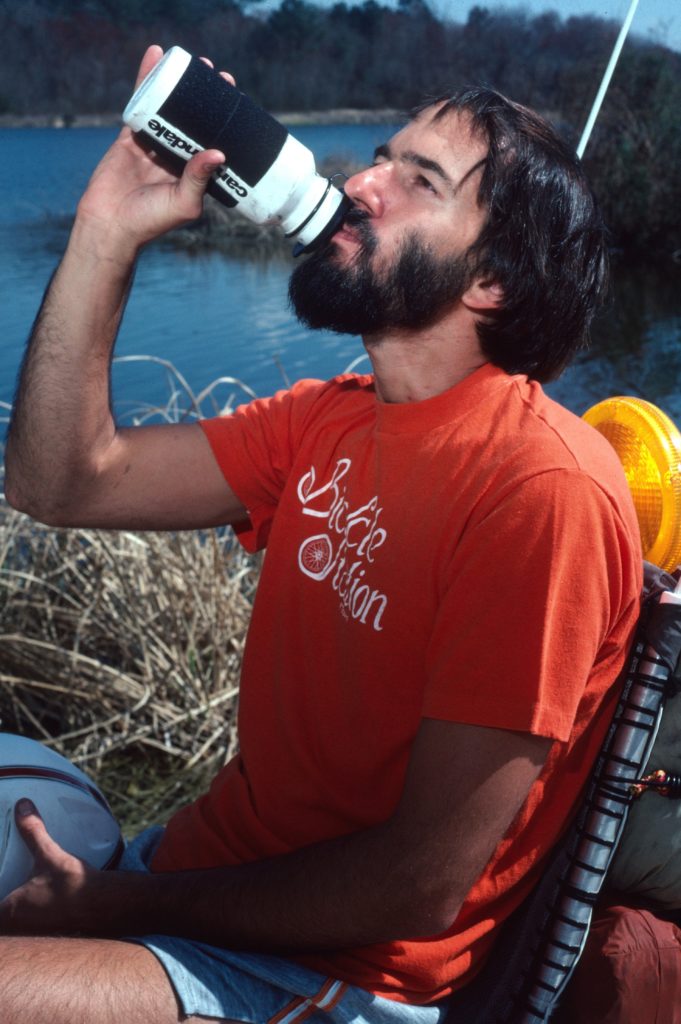
But I met three cross-country cyclists in Clearwater who astounded me. They were headed for the West Coast — for that symbolic mecca of California culture called “Los Angeles.” Their trip was scheduled precisely, the most direct route plotted in painstaking detail on a sheaf of maps. They would ride for six days straight and rest on Sundays, and they had decided to grant themselves one slack day per week for repairs, bad weather, or illness.
I thought them insane. “Uh, what if you find a place you like?” I asked the cleated pilot of a silver Colnago.
“What do you mean by that?”
“Well, suppose you fall in love or find a nude beach — or decide to climb a mountain somewhere. Or I don’t know, what if you just get lazy and feel like lying around? Can’t you take a few days off to explore the country you’re riding through?”
“We don’t have unlimited time and money, you know.”
“Yeah, I realize that, but who says you have to make it all the way to L.A.? Wouldn’t it be equally acceptable to stop in Albuquerque or El Paso?”
They laughed derisively. “Now what would be the point of that? We’re going cross country, man!” They were dressed in sleek Italian racing garb and were all quite macho — and I knew the conversation would end the moment they had used up their hourly five-minute rest period.
“So you’re going to go all the way to L.A. even if you have to push so hard that you hurt yourselves?”
“Hey, look. I don’t know what your trip is, man, but we’re going to see the Pacific Ocean by March 15.” He glanced at his watch and fastened his helmet. “You guys ready?”
I sat on my comfortable bike and shook my head. “Well, good luck. I hope you succeed.”
“You shooting for the coast?” The question sounded competitive.
“Who knows? Seems likely — I’m headed in that general direction. Could be next year, though. I’m not really into straight lines or schedules.”
“Well, whatever.” I think he was annoyed that I didn’t want to race them across the United States. They pushed off, muscling away from the starting line in a flash of pedals and spokes.
“Power to your legs!” I called, and one of them waved in unsmiling acknowledgment of this bike-racer’s cheer, entirely missing the irony. Phew. I watched them go without the slightest envy, then strolled with deliberate laziness down to Clearwater Beach. It was hard to comprehend that kind of thinking: I sure wouldn’t be able to crank out those hundred-mile days, one after another. But they would. Those were the kind of athletes who would fight the obstacles, hide the pain from each other, and arrive at their distant finish line with jubilant shouts of shared victory.
“Be here now!” I wanted to shout after them. “Live for the moment!” But I just would have sounded like a bearded carryover from the sixties. We were of different realities, the macho cyclists and I, and there was no point in discussing it.
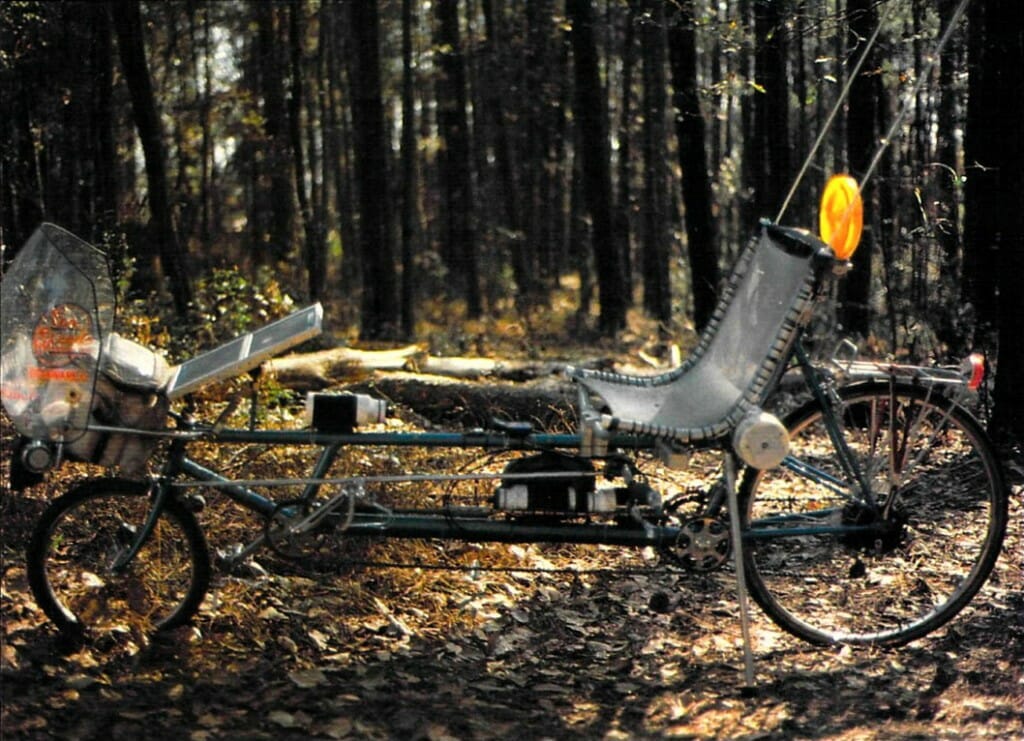
I recalled a letter that Barbara had sent me, quoting 81-year-old Nadine Stair on how she would live her life over:
“You see, I’m one of those people who live sensibly and sanely hour after hour, day after day. Oh, I’ve had my moments, and if I had it to do over again, I’d have more of them. In fact, I’d try to have nothing else. Just moments, one after another, instead of living so many years ahead of each day…”
Well, I was sure having my moments.
One of them happened right there in Clearwater. I met Katy on the beach and moved in with her for a couple of days to read, relax, and enjoy her keen wit. She was an experienced sailor and budding freelance photographer, and we did a photo session that yielded some of the best shots from this part of the journey.
The second night, late, we were talking in her bare candlelit living room. She was relating a tale of adventure on the high seas when we began hearing flute and guitar frolicking nearby.
The sound was coming from an open window next door. Katy had just moved (no electricity yet — the candles were not, alas, for romance) and she knew none of her neighbors. I grabbed my flute and we crept outside, slinking through the yard, hiding behind the trees, shaking with suppressed giggles. At last I crawled to the window and crouched low, hardly breathing. The sound pouring from within was smooth and professional.
Could I hope to fit in with this perfection — and would I be welcome if I did? I tried to relax, conscious of my listeners: Katy, the musicians, and doubtless a dozen neighbors. Would I come in on the right key? Would I poke around in embarrassment, blowing softly and sounding flat? I closed my eyes and listened, letting the music pervade me until I suddenly realized I was playing along.
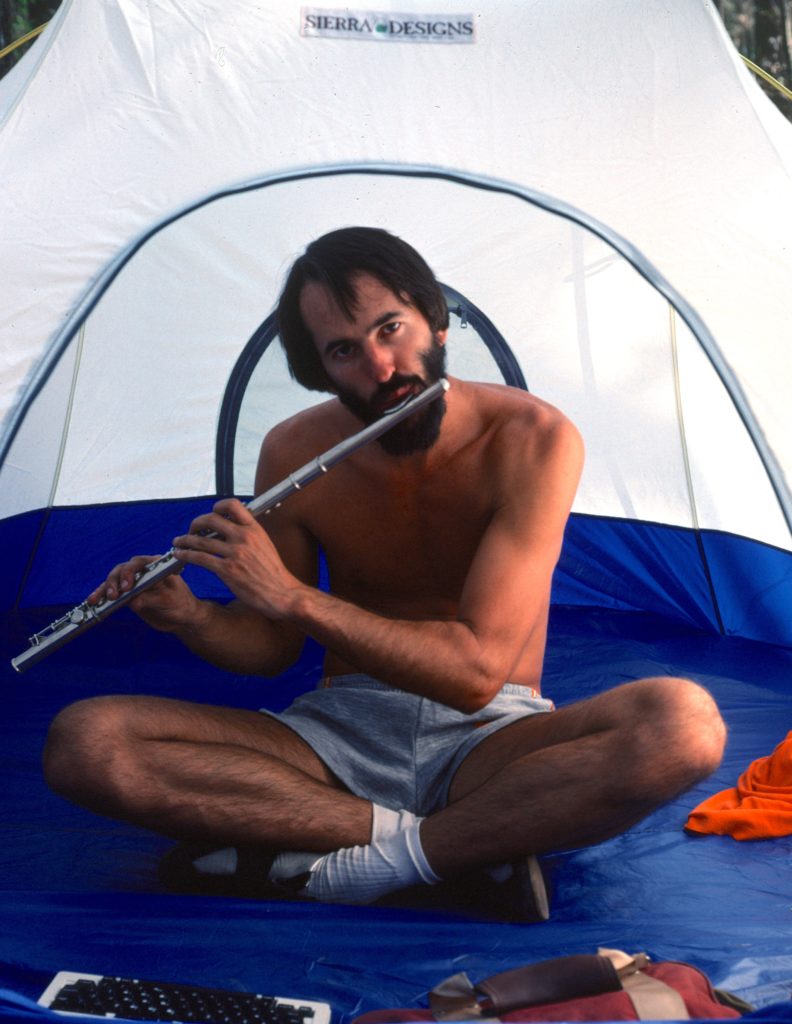
We tossed the theme back and forth, teasing, laughing with our sound, moving from the playful to the funky and back again. Katy leaned against a tree, eyes closed; I knelt in the sandy soil of their garden and shared a moment of musical bliss. Somewhere in all that we found a resolving tonic and hit it in sync as if an invisible band leader had dropped his baton. I heard movement inside… then two grinning faces appeared in the window and peered into the darkness.
For the next hour I received lessons in technical blues from the pros. They disassembled its harmonic structure; they explained timing, modulation, and the differences between aeolian and mixolydian modes. I don’t remember a word of it, and my attempts to perform were disastrous. “Give me a 1-4-5 on E-flat,” one said, and I had to count up from C.
Like Snooper, I can only play what I feel. Snooper is a Clearwater cockatiel who sings the Alfred Hitchcock theme when, and only when, perched on the shoulder of someone going to the bathroom.
On the road again, northbound along Florida’s west coast in the slowly cooling tire tracks of the macho cyclists. Highway 19 is a four-lane midway of plastic, neon and exhaust fumes, and a common rush-hour bumper sticker reads: PRAY FOR ME. I DRIVE ON US 19. After 45 miles of this and two flat tires, I was ready for a place to sleep. Signs promised a campground ahead.
Suddenly, just south of Weeki Wachee, a fellow standing on the side of the highway began waving his arms and calling, “Stop! Stop! My boy called and said I had to come out and see this modified bike!”
“Well, I can only talk for a second,” I replied. “I need to find a campground before dark.” This was designed to plant the seed of an invitation — I had come a long way since that first awkward night in Thackery.
He extended his hand. “I’m Mike Fleischer, editor of the West Hernando News. I’d like to get a picture of you, if that’s OK.” He pointed across the street to the newspaper office.
I agreed, and as we chatted our way over to the low building I could see that this would be more than a routine interview. Mike mentioned that he had just written a story about a Dutch cyclist who has been on the road for two and a half years — and who also happened to be staying at his house.
“You seem to attract touring cyclists,” I laughed.
“Well, actually, my dream is to gunkhole around the world on a sailboat.” Mike had been in the news business for thirty years or more, much of it as a Navy man. The lure of the world was inside him, and he always welcomed travelers.
Within the hour I found myself at his suburban home in Spring Hill, wrestling the bike through the front door. I parked in the living room and met 37-year-old Tom Rijven (try saying “raven” in a dramatic British accent while clearing your throat in the vicinity of the soft palate). We shook hands and stared at each other’s vehicles in mutual amazement — his minimal touring system seemed barely enough for a fair-weather weekend jaunt, much less two and a half years of rugged international travel. He carried few clothes and lived without a tent or sleeping bag.
But Tom had gotten around. He left Amsterdam in August of 1981, and had toured Belgium, France, Italy, Greece, Cyprus, Israel, Egypt, India, Sri Lanka, Singapore, Malaysia, Thailand, Indonesia, Australia, New Zealand, and even Tennessee. He took his time, unlike the macho cyclists, stopping here and there to work or sample local culture.
I began to realize as we talked that even though America was not turning out to be nearly as TV-homogenized as I had expected, it was still one country, one overall culture. Tom’s international experiences put that into perspective:
“In this country,” he said, “it’s OK to put your arm around a girl or walk hand-in-hand with a single woman, but it’s not OK with a man. In Egypt, it’s OK to put your arm around a man but not a single woman. In Asia, it’s OK to walk hand-in-hand with a man, but it’s not nice to do it with a woman, especially a single woman.”
We certainly are an ethnocentric bunch, I remember thinking. Americans, as a general rule, have a hard time realizing that the rest of the world exists beyond the level of abstract news stories and vague schoolbook memories. I had flown to Tom’s homeland once to speak at a conference, and it took me a few days to get over my embarrassing surprise that there was more to Holland than windmills, dikes, wooden shoes, tulips, public saunas, and Radio Nederland. Life went on in Amsterdam just as it did in Columbus; there were people of all descriptions, delivery trucks for board game companies, computer stores, silly bumper stickers, and broken pay phones.
Of course, few people have an accurate internal model of the world, culturally or geographically. Distances are distorted; far-off lands blend together. I saw an example the very next day…
I was heading back to Gainesville — back to Sylphide. At the first reasonable opportunity I escaped the madness of US 19 and turned inland on little roads to the much more mellow US41. The land grew pretty again, gently hilly, the Spanish moss embrowned by the recent December cold snap that had ruined the citrus crop and broken the dreams of more than a few Mexican families. It was a fast day of dramatic tailwind, with black sky ahead and blue above.
Near Homosassa Springs, I stopped at a roadside orange stand and paid thirty cents for a 24-ounce glass of fresh-squeezed juice. “Where’d ya come from on that?” asked a guy in the parking lot.
“Well, I just rode up from Clearwater–” I began.
“Clearwater! You gotta be kidding me!”
“Uh, that was just the last couple of days. I started in Ohio.”
“Man, I can’t believe you rode that from Clearwater. How far is that, about a hundred miles?”
“About sixty. I’ve done a little over three thousand since I left Ohio.”
“Ohio — that’s up in the middle somewhere, ain’t it? Up ’round Iowa, Pennsylvania? Man… all the way from Clearwater. Phew! That’s really something. No motor, huh?”
Clearwater had a place in his internal model of the world — it was a comprehensible distance, an hour by pickup truck. Ohio was like Holland or Vietnam or Patagonia — a place that doubtless exists but is just too remote to think about. This scene was repeated often across the country as people struggled to put my travels into personal context.
Of course, it was just another version of what I was going through myself. I’ve flown to most of the hot conference spots around the country at one time or other, yet I had only a vague notion of how they all fit together (air travel does little to knit places into a geographical whole). But as I cycled the country, my simplistic mental map took on substance, changing from an abstract outline with a few pockets of detail into something real and amazingly large.
As I approached Gainesville, however, I had to wonder how a lifestyle of intense moment-to-moment educational experience could ever fit into the context of a stable relationship.
One was being offered. Sylphide was waiting.


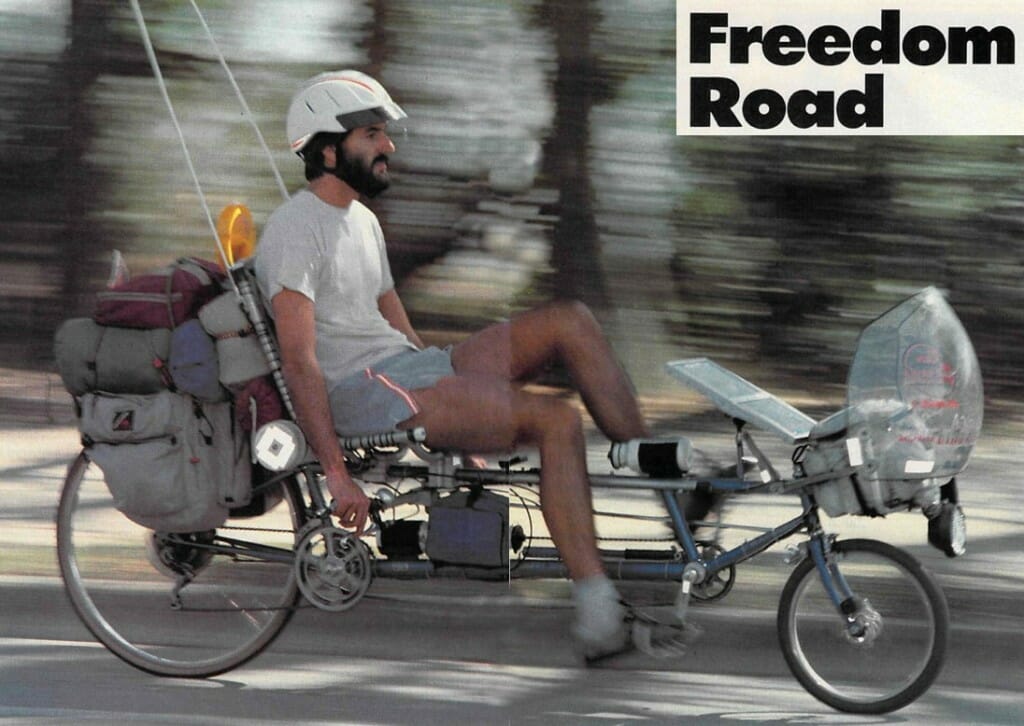
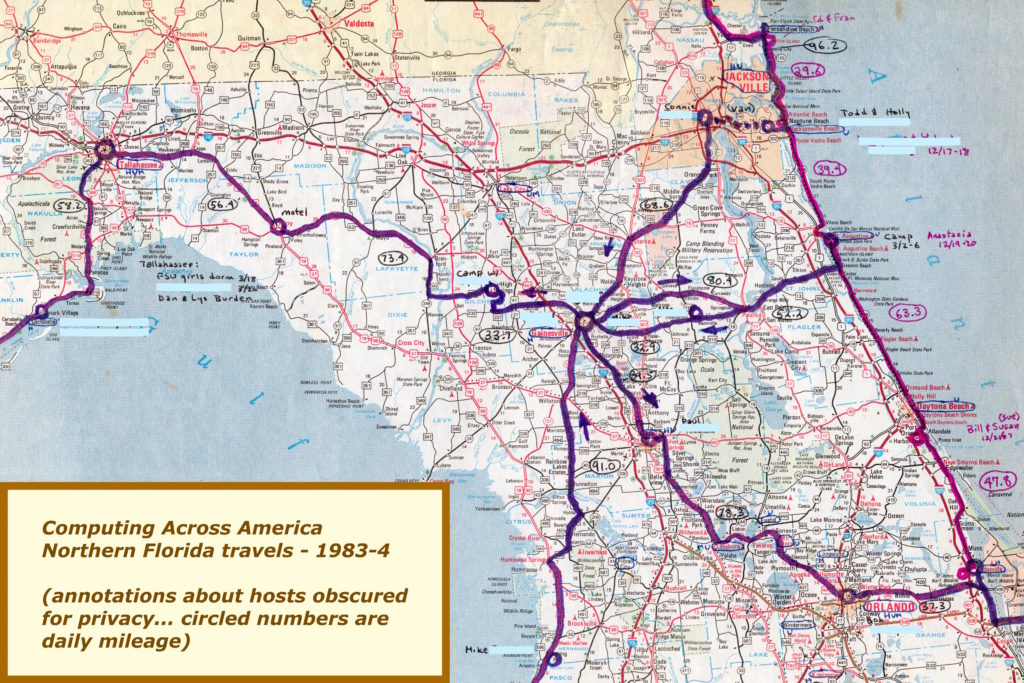
You must be logged in to post a comment.